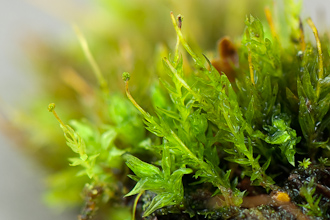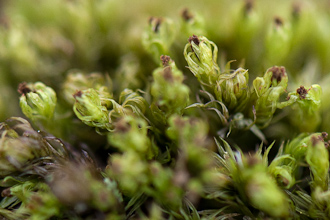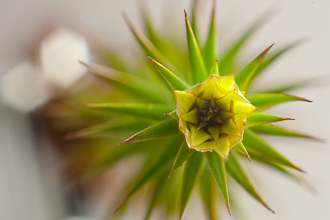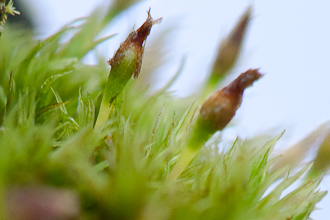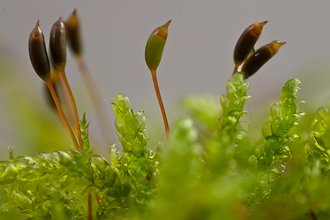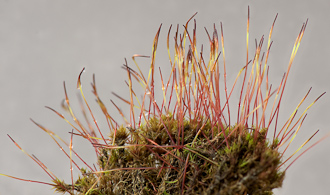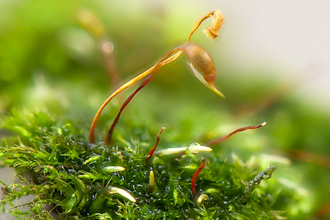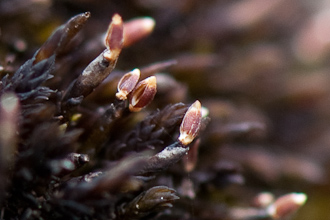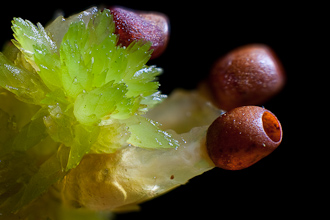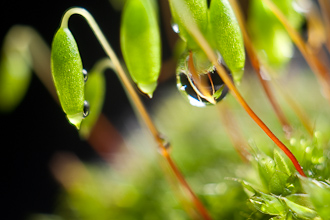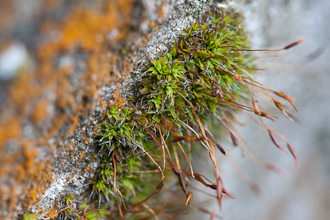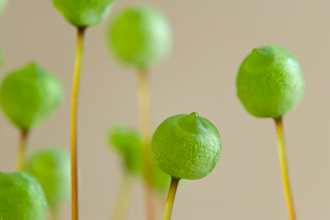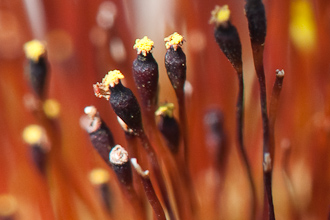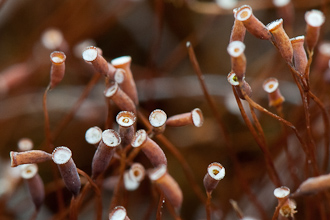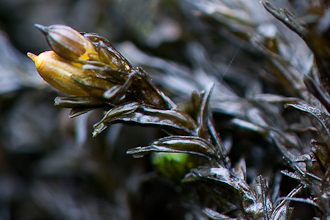
-
Plant growth habit
-
Shoot growth form / colour
-
Arrangement of the leaves
-
Details of the leaves
- Hairpoint:
-
Leaves recurved, hooked, squarrose
Note:
Apices bent abruptly to the side or downwards - Costa:
- Teeth:
- Leaf margins:
- Leaf surface:
-
Reproductive structures
- Distinctive gemmae present:
- Colour of seta:
- Form of the capsule:
Note:
Distinctive capsules only.
Mosses have evolved a surprising variety of means of vegetative reproduction, where some part or structure of the gametophytic plant is released from the parent to establish further individual plants.
The reproductive propagules range from deciduous shoots which simply break off the parent (as in species of Campylopus), to various sorts of gemmae and tubers comprising clumps of cells which have resources to help establish new plants when they reach a suitable substrate and environment. Gemmae can be carried aloft by special structures, or just distributed on some part of leaf surfaces, while tubers can be found in the soil amongst the rhizoids which play a root-like role for the gametophyte above.
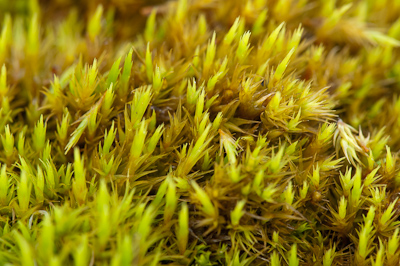
In many species of Campylopus, the shoots are fragile and readily separate from the parent plant to act as vegetative propagules. Moss photographed at Rubha nan Sasan, Loch Ewe in the Scottish Highlands. (ID tentative)
Sexual reproduction in mosses takes place when male and female haploid gametes come together to form the diploid sporophyte. The gametes are produced on a variety of structures on the green leafy plant, both sexes sometimes occuring on one individual, while other species have separate male and female plants.
After fertilisation, the diploid plant or sporophyte is formed, comprising a haustoria-like foot embedded in the gametophyte plant body, from which extends the seta or stalk surmounted by the capsule. Meiosis takes place in the capsule to produce large numbers of tiny haploid spores. After dispersal, spores landing on a suitable substrate germinate, forming a green thread-like plant body called a protonema which is reminiscent of a green alga. The leafy gametophytic plant arises from the protonema and the cycle continues.
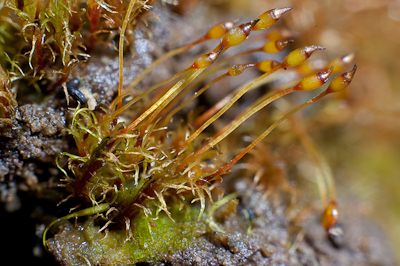
The green mat formed by the protonema that gave rise to the leafy and capsule-bearing mature moss, can be seen in this picture of Dicranella rufescens. On bare soil in a drainage ditch near Daer Reservoir, South Lanarkshire.
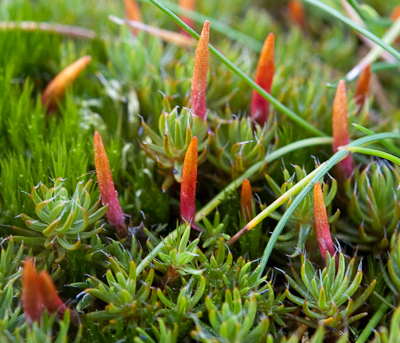
Young sporophytes on Polytrichum piliferum made very conspicuous by the bright orange calyptra on each capsule. In mosses, the seta begins to elongate before the capsule is mature, a fragment of the female repoductive organ (the calyptra) being ruptured from the haploid plant and carried aloft. Experiments have shown that the calyptra is required for normal capsule development. As the capsule matures and expands in P. piliferum, the calyptra appears more pale in colour due to the development of copious hairs.
Photographed growing on rocky soil on Arthur's Seat, Edinburgh.
-
British Bryological Society
The BBS
Promoting the study of mosses and liverworts in Britain and Ireland -
The Plant List
The Plant List
Bryophytes section of the list maintained by Kew et al. -
Bryophyte Ecology, Janice M. Glime (2007)
Bryophyte Ecology
A large a comprehensive account of bryophyte ecology -
Plant Physiology, Ross E. Koning (1994)
Plant Physiology
Numerous images illustrating bryophyte anatomy -
The Hidden Forest
The Hidden Forest
An informative site on New Zealand cryptogams, including bryophytes -
Andrew's Moss Site
Andrew's Moss Site
Image gallery and on-line keys featuring north-temperate mosses -
Bildatlas der Moose Deutschlands
Bildatlas der Moose Deutschlands
A collection of attractive plates of all mosses growing in Germany -
Clare Rickerby Freelance Botanist
Clare Rickerby
Based in Scotland, specialising in bryophyte and upland vascular plant surveys
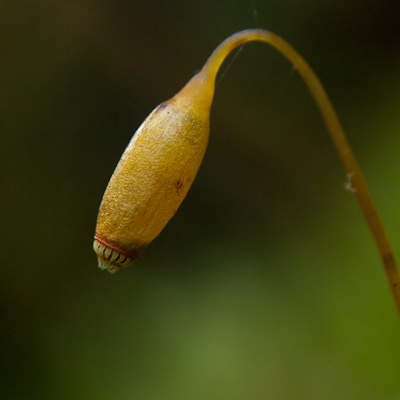
At the mouth of the capsule in many mosses, spore release is regulated by hygroscopic peristome teeth. Although the number and structure of peristome teeth is an important phylogenetic character, I haven't seen it much used as a field character, presumably as it requires microscopic examination. However, the peristome teeth on this capsule of Mnium hornum can be clearly seen even with modest magnification.
The background research I've carried out to put together these character lists for the more common mosses found in the UK, has highlighted for me just how many characters exist in mosses. Mosses are obviously less structurally differentiated than flowering plants, but within the small range of tissus they possess, there's an amazing variety of form. Indeed, if mosses were much larger, or we were much smaller, we would be surprised at the diversity in geometric form shown by moss shoots and leaves.
In these pages I've covered some of the more conspicuous characters with an emphasis on those that can be observed with no more magnification than a x20 hand lens. But even at these scales, there are many details of leaf and capsule form, for example, that could be added here with the associated species.
It's my intention to revisit these lists from time to time, adding further species to the lists as well as enhancing the content by including further morphological and anatomical characters.
- Aulacomnium androgynum
I'll be researching into whether similar gemmae-bearing structures occur in other mosses in Britain and Ireland, but for now I list the only species I know with this structure.
- Ulota phyllantha
- Polytrichum juniperinum
- Polytrichum piliferum
The position of the "cup" at the top of an erect shoot contributes to the surprisingly flower-like appearance, as the photo of a male gemetophytic plant of Polytrichum juniperinum shows.
- Atrichum undulatum
- Brachythecium plumosum
- Bryum capillare*
- Dicranoweisia cirrata
- Tortula muralis*
- Ulota bruchii
- Weissia controversa*
- Brachythecium rutabulum
- Bryum capillare*
- Bartramia pomiformis
- Mnium hornum*
- Tetraplodon mnioides
- Weissia controversa*
- Bryum argenteum
- Brachythecium populeum
- Ceratodon purpureus
- Rhizomnium punctatum
- Tetraplodon mnioides
- Amblystegium serpens
- Bryum capillare*
- Eurhynchium striatum
- Mnium hornum*
- Pogonatum aloides
- Rhynchostegium confertum
- Tortula muralis*
- Andreaea spp.
- Sphagnum spp.
- Bryum capillare
- Mnium hornum
- Tortula muralis
- Bartramia pomiformis
- Tetraplodon mnioides
- Pogonatum aloides
- Orthotrichum rivulare
- Schistidium spp.
I think this illustrates that speculation over the adaptive significance of characters can be suspect, and counter evidence should always be considered.
